The X Button
An Endless World
by Todd Ciolek,

I realize that I've opened the last two columns with discussion of Operation Rainfall, the fan movement that aims to get Xenoblade Chronicles, The Last Story, and Pandora's Tower released in North America. But it's caught me up in the way that a good ol' nerd crusade does, so I'll mention it one more time.
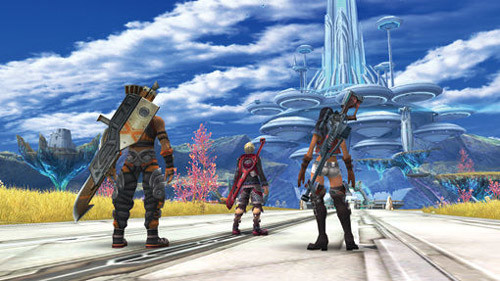
It's convenient, because this week starts off Rainfall's letter-writing campaign. If all goes according to plan, Nintendo will be waist-deep in postcards and letters from people who want to buy a U.S. version of Xenoblade. The Last Story's supporters are scheduled to get their letters in starting on the 18th, and the Pandora's Tower missives will arrive on the 25th. Whether you send your letters in on schedule or not, Project Rainfall wants you to include little plastic swords with Xenoblade letters, book pages with The Last Story letters, and beef jerky with Pandora's Tower letters. That's because these items reflect the games' themes in some way, though I like to think that someone discovered a clause in Nintendo's charter, dating all the way back to their 19th-century playing-card days, which states that the company will comply with any request accompanied by dried and salted meat.

The other relevant news is Operation Rainfall's claim that Xenoblade and The Last Story are indeed scheduled for North American releases, despite Nintendo's polite statements to the contrary. Citing a “source within Nintendo,” the Operation Rainfall blog reports that both games are currently being localized within Nintendo, though there's no word on Pandora's Tower.

Even if this is true, I'm a shade disappointed. Of the three games, Pandora's Tower is the most interesting to me, what with its Ico-like concept and extensive use of a grappling chain. I'm a sucker for any game with grappling weapons. Pandora's Tower doesn't have such an accomplished pedigree as the other two titles, as developer Ganbarion's resume is mostly anime-based stuff. Yet I hope it'll come here, and I'm prepared to send in two Slim Jims if the cause demands it.
NEWS
SQUARE ANNOUNCES THEATRHYTHM, AT A LOSS FOR WORSE TITLES
Here's further evidence that all jokes eventually become real: back in 2001, The Gaming Intelligence Agency ran an April Fool's gag about Funky Fantasy, a music-based mini-game in Final Fantasy X. It wasn't real then, but we're coming closer. Square Enix's latest spin-off in its most abundant franchise is Theatrhythm: Final Fantasy, a music RPG for the 3DS.

Theatrhythm's flow is much like a typical Final Fantasy: players command a party of cutely squat characters and explore dungeons full of everything from imps to behemoths. However, all of the battles are carried out in the manner of rhythm-action games, as players tap on-screen buttons that correspond to musical notes. The music is, of course, made up of selections from thirteen Final Fantasies, and the game contains a separate episode for each.

The storyline effectively makes Theatrhythm a spin-off of Dissidia: Final Fantasy, as various characters from the franchise are called upon to take part in a battle between order and chaos. Squat, puppet-like versions of familiar Final Fantasy cast members form the game's four-member parties, and the lineup so far includes Final Fantasy VII's Cloud, Final Fantasy V's Bartz, Final Fantasy III's Onion Knight, Final Fantasy's Warrior of Light, and Final Fantasy XIII's Lightning. And there's a chocobo. Always one of those. Theatrhythm has a winter release date for Japan, and it stands a darn good chance of coming to North America.
EXE-CREATE'S LOST ANGELIC CHRONICLES MAKES SURPRISE DEBUT
As much as pundits like to talk about the Japan-made RPG sliding into irrelevance, the genre keeps showing up on Western shores—and in unexpected places. Exe-Create's Lost Angelic Chronicles of Frane: Dragon's Odyssey walks this curious inroad. It's obscure by any standard, but Exe-Create's bringing out an English version for PCs.
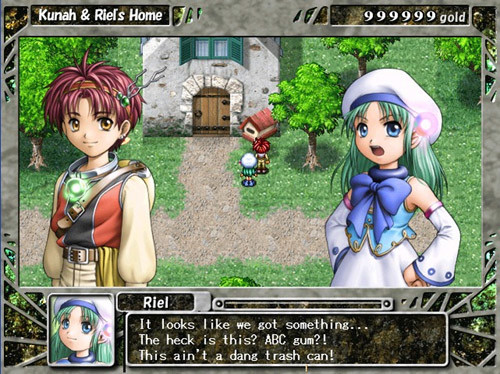
Much like its Mad Libs puzzle of a title, Lost Angelic Chronicles of Frane combines a lot of RPG elements. The combat is likened to Ys, but hero Kunah's hometown expands throughout the game, ala Suikoden or Harvest Moon. There's also plenty of dialogue, and the player's decisions determine what ending will result—and which girl will end up with Kunah.
Exe-Create already has English screenshots ready, and they look to be carefully translated at that. It's an interesting move for the company: while they've been in the business since the Saturn era at least, Exe-Create only recently threw their lot in with the North American market by releasing Across Age on the iPhone. Lost Angelic Chronicles of Frane is scheduled to hit Steam and Gamers Gate in August, and Exe-Create's using it to test the waters for some of their other RPG series.
METAL MAX RETURNS YET AGAIN
Metal Max has survived a lot: the downfall of publisher Data East, the lukewarm success of Metal Saga in North America, and the trend of second-string RPGs favoring cute female characters instead of post-apocalyptic tank warfare. Yet Metal Max continues, peddling a brand of RPG where nuclear wastelands and combat vehicles replace mystic caves and swords. Its latest installment is a remake of Metal Max 2 on the DS.
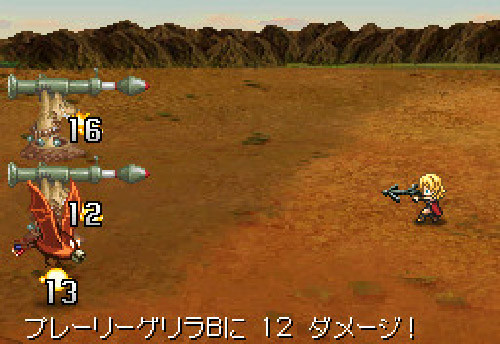
Backed by Kadokawa Games, the Metal Max 2 remake lands its player-named hero or heroine in Mado, a downtrodden city where the main industry lies in mad scientists reviving corpses. The player takes up work as a bounty hunter, starting with hand-to-hand combat and later buying heavily armed cycles, buggies, and Leopard tanks to fend off the creatures of this catastrophe-blighted land. If it looks familiar, that's because the remake's graphics are based on the recent DS-based Metal Max 3. Will it come to America? Well, the DS is fading rapidly here and no U.S. publisher has touched Metal Max since the largely neglected Metal Saga of 2006. You can figure it out from there.
IN BRIEF: KING OF FIGHTERS XIII OUT IN OCTOBER, SDATCHER IS NOT MISSPELLED
Atlus has The King of Fighters XIII fast-tracked: the game will arrive in North America this October with its Neo Max super moves and a bunch of characters absent from The King of Fighters XII. SNK continues to add familiar faces to the console version game: Billy Kane was announced earlier this month, and at least one more character will be available as a download—or free if you reserve the game in Japan. Smart bets on who it will be: Blue Mary and Yamazaki. Dumb bets: Brian Battler, the football warrior from The King of Fighters '95.
Fans of Hideo Kojima's classic adventure game Snatcher were worked up over rumors of a “Project S” game in development not so long ago. Kojima and Grasshopper Manufacture recently revealed what it is: Sdatcher, a radio drama based on Snatcher. It's not clear how Sdatcher involves Snatcher's world of Blade Runner and Terminator elements (or how you pronounce the title), but it'll have music by Akira Yamaoka (Silent Hill) and a script by Suda 51 (Killer 7). That's nothing to sniffle about.
REVIEW: CHILD OF EDEN
 Developer: Q Entertainment
Developer: Q Entertainment
Publisher: Ubisoft
Platform: Xbox 360 (now)/ PlayStation 3 (September)
Players: 1
MSRP: $49.99
Something about Child of Eden bothers me. I don't mind that the game can be finished in about two hours. Rez, Tetsuya Mizuguchi's previous sound-fueled shooter, was just as short and just as spectacular. And I don't mind that Child of Eden's delirious landscapes of glowing wire-frame jellyfish and punchy techno are such a sensory wonder that it's hard to avoid tired comparisons to drug use. I'll do my best. No, what bothers me ever so slightly is that Child of Eden shows a real person in its world.
The real person is singer Rachel Rhodes. She plays a digitized recreation of Lumi, the first space-born human in the sparingly told backstory that unites Child of Eden and Rez. Lumi is shown prominently in the game's brief introduction and appears sporadically through the game, smiling with impish, Björk-like serenity amid the neon fauna and flora that fill the world of Child of Eden. The sight of an actual human in such an abstract realm is a bit jarring. Tasteful as it may be in Children of Eden, the mere concept of live actors in video games reminds me of awful Sega CD games or Stepping Selection videos. And that's the only real complaint I can justly make about Child of Eden.

Because Child of Eden is wonderful. It's also quite simple. You're a viewpoint, a targeting cursor that floats through the galactic kaleidoscope of a computer network, wiping out all manner of viral creatures. Your cursor fires in two flavors: red lock-on shots and rapid purple shots. Most enemies can be defeated by lock-on lasers, but they often spew purple projectiles that can only be taken down by your own purple blasts. The game's scoring rewards those who lock on to as many targets at once before firing, though that's harder to do when you're trying to shoot down everything before they swim off the screen.
Those are the basics, and it's all taken to fascinating extremes by Child of Eden. The game's a beautiful concoction of gorgeous colors and consistently striking style (well, mostly consistent). It glides through alien tunnels of polygonal sea snakes and unfolding subterranean towers. It plunges through a primordial garden where flowers sprout flying protozoa and giant butterflies pinwheel around to confuse your aim. It pits you against two clashing globes, whose every collision throws off nasty purple homing shots, before tossing you into a cubist cityscape of whirling gears and jutting skyscrapers.
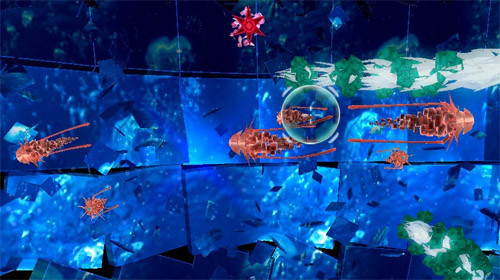
And it all sounds amazing. Child of Eden has the same idea as Rez: every shot fired and every enemy destroyed gives off a musical note, from the drum beat of your own purple autofire to the twangs of the demolished panels on a spinning satellite. The sounds vary dramatically from stage to stage, and it's all backed by pulsing, frequently changing beats from Genki Rockets. It's helped by some excellent, quick-paced level design. The game's first stage is somewhat forgiving, but it grows into a challenge akin to the best of classic rail shooters like Panzer Dragoon and Sin and Punishment. However, Child of Eden doesn't have a player avatar on screen, making it impossible to actually dodge oncoming projectiles. You've got to shoot them down or take the hits, which limits players in their options. And what of Rez's little wire-made hero?
Child of Eden is, as I mentioned before, fairly short. The game's five levels are all varied in sights and sounds, but they last about 15 minutes each. To make up for this, the game requires to unlock every stage after the first. Simply beating a level isn't good enough; you need to earn stars from finishing it. Each stage gets tougher and stingier with stars as you progress, so you'll have to replay them several times. This seems a problematic solution; while Child of Eden is hard to get sick of, it's not quite as fun when you're forced to replay it. Oh well. You can always just set the game to its lowest difficulty level.
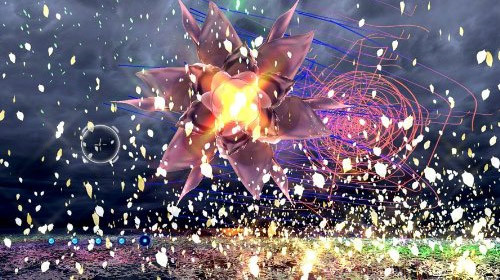
Child of Eden is perhaps the first title to really push Microsoft's new motion-sensing Kinect. The game plays perfectly fine without it, but it becomes a curious new experience when run through the Kinect. The motion detection isn't quite as reliable as a good ol' controller, but it offers a greater range of movement and really plays up the mesmerizing raver sensibilities of the game. If you're in search of the perfect game to show off the Kinect, Child of Eden is essential.
Child of Eden is also essential for anyone who wants a rewarding, stunning, trance-inducing shooter. Ignore complaints about the game's length. It's a remarkable experience that stands apart from the majority of modern games, and that's more than enough reason to return to Child of Eden time and time again. Real or not, Lumi's all right with me.
NEXT WEEK'S RELEASE
CALL OF JUAREZ: THE CARTEL With the rest of next week's lineup occupied by The Smurfs and Captain America games, Call of Juarez: The Cartel emerges as the frontrunner by default. This isn't the game that players came to know in the first two Call of Juarez titles, with their Old West themes and sixguns and lost treasures and racism and violence and lack of bathing. No, The Cartel moves the whole Call of Juarez series to modern-day Mexico, where players are now police officers beating back a bloodthirsty criminal empire. The main characters include an up-and-coming FBI firebrand, a general-purpose tough cop, and a detective with a gambling problem. All of them gun down criminals, drive unsafely, and spout quips in first-person stages, fighting a private little war against Mexico's cartels and teaching kids that, just like William Sessions said, winners don't use drugs. Previews of the game suggest that it's messy and clichéd, but it's too late to go back to the Old West now. |
discuss this in the forum (18 posts) |
this article has been modified since it was originally posted; see change history
 Developer: Techland
Developer: Techland